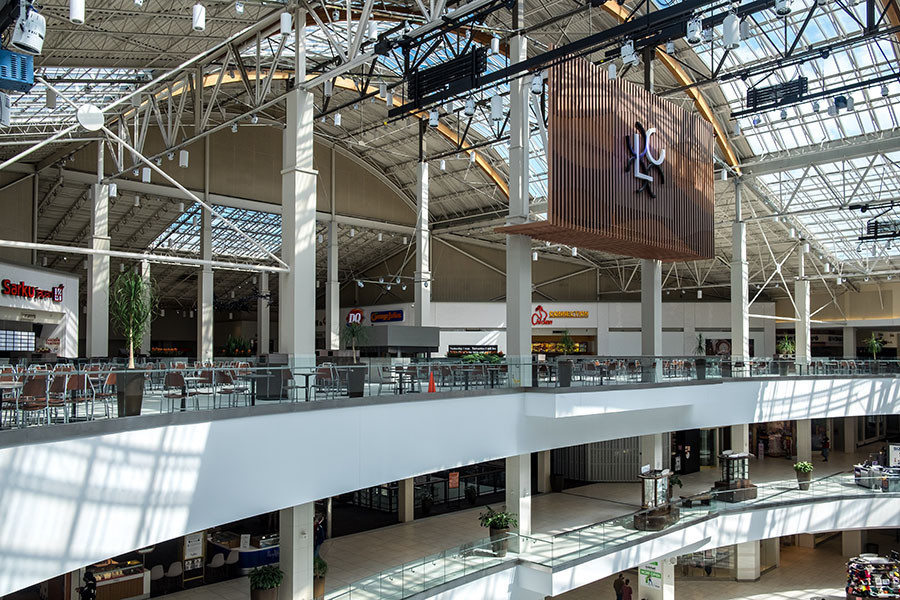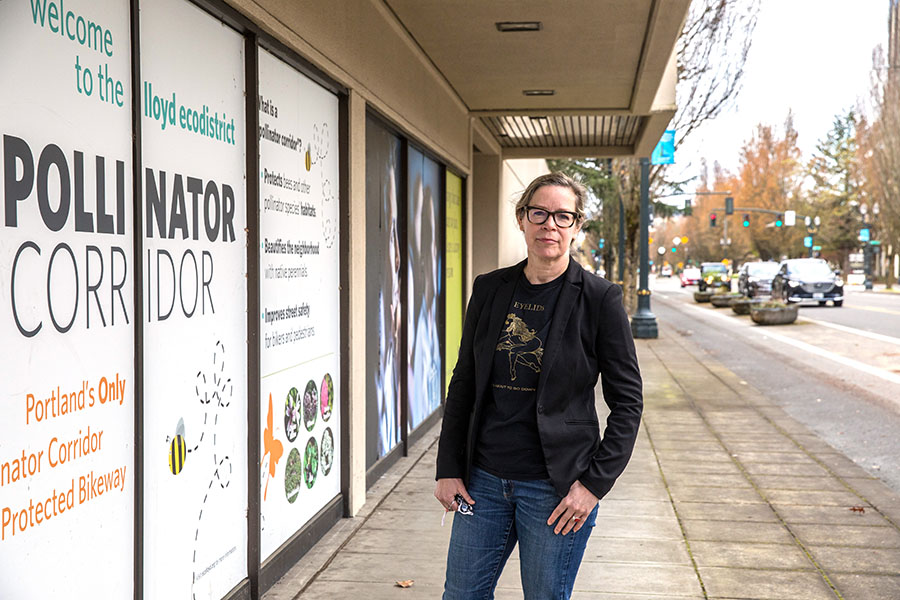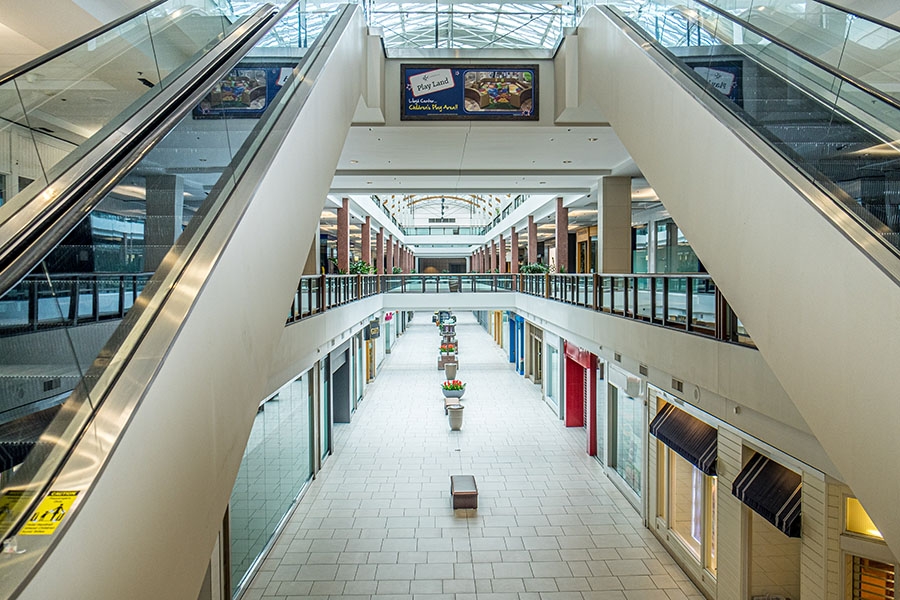Driven by bankruptcies, redundancies and the rise of e-commerce, the retail sector has been in flux for years. COVID-19 accelerated the shift. Oregon’s malls can either reinvent themselves to stay vital or they can fail.
It is a late Tuesday afternoon and the foot traffic in Washington Square Mall in the Portland suburbs looks brisk by COVID-19 restrictions standards. Families with strollers and small children in tow, groups of teens just dismissed from distance learning and older couples stroll the wide halls, dropping their masks to sip a drink or lick an ice cream cone.
Some stores — high-end beauty retailer Sephora and teen-friendly clothing vendor Hot Topic — have lines of shoppers waiting to enter the store. Other shops are stocked with product but devoid of people, aside from sales staff trying to look busy by wiping down counters while casting a wistful eye out to the hallway traffic.
Even with its limited capacity and spotty popularity of its stores, Washington Square Mall feels like it is sprouting back to life. But the feat is no accident. Malls in Oregon and around the world have been falling out of favor for years as retail habits evolve.
Properties that adapt may be able to survive, even thrive. Others are in for a rough go. Some may just die outright, possibly taking whole neighborhoods with them.
Shopping is not what it used to be.
Driven by a combination of the economy, long-standing trends and ever-changing consumer whims, the retail sector is volatile by nature. “As an asset class it is always evolving, more so than the office sector,” says Chris Nelson, principal at Capstone Partners and Northwest chair of the Urban Land Institute. “There are always winners and losers, but this time the survivors are going to be a different crew.”
Blame the pandemic. Like in every other aspect of life, COVID-19 restrictions supercharged existing realities and accelerated trends. For retail, that looks like more online shopping; more consumers choosing discounters like Target, Walmart and Kohl’s; and the continued rise of outward-facing lifestyle centers that mimic urban downtowns with pedestrian-oriented streets and lushly planted landscaping.
And the slow downward spiral of the classic mall.
 Northeast Portland’s Lloyd Center, once the state’s largest mall. Photo by Jason E. Kaplan
Northeast Portland’s Lloyd Center, once the state’s largest mall. Photo by Jason E. Kaplan
Classic malls — indoor-facing, apparel-focused behemoths, anchored by a couple of department stores and surrounded by acres of parking — have felt the stress for years.
Some of that is due to consumers choosing to shop at strip malls and big-box discount stores. But a lot of the classic malls’ woes rest on bigger market forces.
“There was a strategy of penetrating the market with as many brick-and-mortar locations as possible to increase the share of wallet,” explains Ryann Reynolds-McIlnay, assistant professor at the OSU College of Business, adding that this led to the old joke about “a Starbucks on every corner.”
It also led to the U.S. having the largest retail footprint in the world: 23.5 square feet per capita in 2018, compared with 16.8 in Canada and less than 5 in France and the U.K.
“We were overbuilt,” says Reynolds-McIlnay. Around the same time, private equity firms used leveraged buyouts to hoover up retailers and saddle them with debt. “This prevented those brands from investing in their technology infrastructure just as Amazon and online shopping was taking off.”
This perfect storm created the “retail apocalypse,” a term bandied about since at least 2017 to describe bankruptcies, buyouts and market contractions.
At the same time, unique, regional department stores — think Meier & Frank —were in for their own sea change. A series of buyouts and consolidations left just one company, Federated Department Stores, holding them all in 2005.
This strategy created redundancies for a property anchored by two or more department stores and eventual closings.
For a mall, bouncing back after losing an anchor store can be next to impossible. After all, a large, empty, boarded-up box is a depressing blight on its surroundings. “Malls need action and activity. They win tenants by having other tenants,” says Sara Daley, principal broker at Commercial Realty Advisors Northwest.
On the other hand, Stephanie Cegielski, vice president of research and public relations for the International Council of Shopping Centers, says losing an anchor “presents an opportunity to bring a different anchor in or to turn the space into something demanded by the community.”
She points to a new class of tenants that range from retail to education to office space. “Currently, many of those boxes are serving as mass vaccination sites,” she adds.
Still, a pivot like this is not an easy prospect thanks to sky-high rents, complicated lease structures and existing tenants who care deeply about things like parking.
“There are so many requirements about who can and cannot be in a mall,” says Daley, noting that these covenants are created when a mall is built. She says options like churches, day cares or offices are often passed over because of their potential impact on parking spaces. “The decisions have already been made about what it can be.”
Some malls, however, have successfully remade themselves.
The old Beaverton Mall, now known as Cedar Hills Crossing, is probably the most successful example of de-malling, according to Nelson. “The owners have been working on it for about 20 years, and it just gets better and better,” he says.
The shopping center, originally built in 1969 as a classic indoor-facing property has been refashioned into a dynamic, suburban complex. It includes a mix of retail, grocery, entertainment and medical offices.
And, of course, food. “Food is the new fashion,” predicts consulting firm Deloitte, noting how great food and beverage choices promise to drive demand and increase dwell time at a location.
Cedar Hills Crossing hosts a blend of local and national offerings, but the restaurant generating the most buzz right now is Shake Shack. Slated to open mid-April, this would be the first Oregon location for the popular burger chain. It is also a prestigious “get” for the mall.
A few miles to the south sits Washington Square, another classic mall that managed to reinvent itself. Still an inward-facing, fully enclosed mall, Washington Square expanded in 2005 with a wing that broadcasts tenants like Sephora, Williams-Sonoma and the Cheesecake Factory.
It has also managed to hold on to anchors like Macy’s and Nordstrom while attracting unique offerings like electric vehicles from Solo, soup dumplings from Taiwan-based chain Din Tai Fung and Ezell’s Famous Chicken out of Seattle.
“Washington Square is a winner,” says Nelson. “They have phenomenal demographics and really reinvented themselves.”
The mall itself will act as an anchor for surrounding future development. The City of Tigard has been planning the Washington Square Regional Center since 1999 and is updating and refining its vision.
The goal is to facilitate more housing, transportation and business/employment options in the area that are walkable and inclusive.
For this to work, Washington Square must stay vibrant and viable. “The success of Washington Square Mall is very important to the success of the Regional Center,” says Lauren Scott, community engagement coordinator for the City of Tigard. “Due to its size, its location and that it is owned by a single landowner, it has the greatest potential to realize the Washington Square Regional Center’s vision and help facilitate more dense, walkable and transit-oriented development in the regional center.”
The City of Tigard would like to see an increase in housing, particularly workforce or affordable housing. However, building a walkable community will undoubtedly pose challenges.
True, COVID-19 has accelerated the appeal of the suburbs, but how can a car-centric area, anchored by an indoor mall, compete with nearby rising areas like historic and walkable downtown Beaverton?
Scott demurred, “Best left to be answered by Macerich.” (Macerich, owners of Washington Square, did not reply to multiple requests for comment.)
On the east side of town, a different mall story plays out.
The slow demise of Lloyd Center Mall has been well chronicled. Mostly devoid of anchors (Nordstrom, Sears, Marshalls and Macy’s are gone; Barnes & Noble and Ross are still hanging on), only a handful of other retail options remain. To be fair, COVID-19 restrictions play some role in accelerating these difficulties, but the mall has been troubled for years.
“Lloyd Center is a fascinating study in failure,” says Daley.
Enormous, sprawling and aggressively inward-facing to the point of looking like a fortress, Lloyd Center’s architecture drives a lot of its woes. “Its built form does not do it any favors,” says Sarah Heinicke, executive director of Lloyd EcoDistrict.
Daley frames it a bit more bluntly. “It was built like it hates its neighbors,” she says.
Past plans to open up Lloyd Center and convert sections to more appealing uses — entertainment and restaurant hub, concert venue, housing — have stalled or fallen through. Still, Heinicke has some ideas.
“It could be recast as a robust maker space, light manufacturing or value-added warehousing,” she poses, adding that this would change the loading-dock area from a liability to an asset. It is a strategy that other vulnerable properties are making as mall vacancies around the country reach a historic high of 9.7%.
 Sarah Heinicke, Lloyd EcoDistrict executive director, photographed along the pollinator corridor on Northeast Multnomah Boulevard in Portland. Photo by Jason E. Kaplan
Sarah Heinicke, Lloyd EcoDistrict executive director, photographed along the pollinator corridor on Northeast Multnomah Boulevard in Portland. Photo by Jason E. Kaplan
Some mall owners are filling storefronts with medical offices, schools and micro fulfillment centers for last-mile deliveries.
Heinicke, whose office is located in the mall, goes further, imagining a food-cart pod wrapping around the old Macy’s location with a food hall inside or community space, areas for families and pets, even a school.
Heinicke admits that any ideas or efforts will be “dwarfed by the massiveness of the parking” footprint. She also knows that any repurposing will take deep pockets, a high tolerance for risk and a strong connection to the community.
“It cannot be a plug-and-play, Class B mall program outfitted with a Portland blush,” she insists.
When asked about the future of the property, Lloyd Center marketing director Ann Grimmer was predictably opaque. “Lloyd Center will remain an important pillar of this community as we have no plans to close,” she writes in an email. “As institutions and the world around us changes, we are working to continue to find new ways to ensure that Lloyd Center maintains its role as a vibrant hub in the Lloyd neighborhood and Portland community.”
Shopping centers around the state continue to remake themselves. The Bend Factory Stores, located on the city’s south side, is in the middle of a renovation that will include a new exterior look and outdoor dining opportunities. There are also plans to rename and rebrand the property.
“Outlets aren’t dead, but outlets in a small center are challenged a bit,” explains Gary Patterson, founder of Northwest Asset Management, which owns Bend Factory Stores. “Getting away from the connotation of just being a factory-store center — it opens it up to create more variety.”
Along with new stores and restaurants, Patterson envisions an area where people can “socialize and sit around a fire pit, talk or play horseshoes.” He hopes to attract a brewery anchor tenant. “It is the Bend way to stand around a fire pit with a beer after skiing all day.”
Patterson cannot reveal the property’s new name or retail offerings yet, but the project illustrates the relative ease of a rebrand for a smaller property, as compared to something as large as Lloyd Center.
“Regional developers have a higher risk tolerance, they know their community and have the stomach for mixing national and local tenants,” says Daley. She argues larger malls without that mix are not “built for longevity.”
But malls discourage small, local, quirky offerings by requiring long and complicated leases, rents based on percentages of sales, and high common area maintenance charges. “Small businesses do not live in a world where they can imagine revenue that supports this level of expense,” Daley says.
The largest mall operator in the U.S., Simon Property Group, is trying a different experiment to save stressed properties. The group bought struggling brands Brooks Brothers, Lucky Brand, JCPenny and Forever 21 to keep them from leaving their mall locations.
And triggered a mass exodus of other tenants.
“Malls have a co-tenancy clause in their leases,” explains Reynolds-McIlnay. “If capacity dips below a certain number, it will trigger renegotiations for lower rents or ending the lease entirely.”
When looked at this way, the move makes sense. But is it sustainable? “I do not get it,” says Daley, who compares it to “asking a plumber to install an electrical panel.”
Reynolds-McIlnay is a bit more open to the idea. “It depends on how they manage it. Buying a retailer to ensure that the mall continues to receive rent will not be enough. But it gives property owners a diversified income stream of mall, internet and mobile sales.”
Whether the move will provide fresh, new ideas that will save the mall remains to be seen.
“Retail is very nuanced and competitive,” says Daley. “The only way brick and mortar can survive and stay relevant is if it adds value beyond an e-commerce transaction.” That value could be an experience or the expertise of a top-notch salesperson.
One thing that retailers can bet on is the public’s collective desire to get out and spend some money. Global consumers saved $2.9 trillion during the pandemic, according to Bloomberg Economics, and Americans are holding on to most of that cash.
As vaccines continue to roll out and COVID-19 caseloads ease, expect that money to be spent on travel, eating out and shopping, “especially for clothing intended to be worn outside the home,” writes Naveen Jaggi, president of retail advisory services at JLL.
Jaggi expects neighborhood shopping centers “to be the first to return to normal while enclosed, indoor malls will take the longest.”
To subscribe to Oregon Business, click here.







